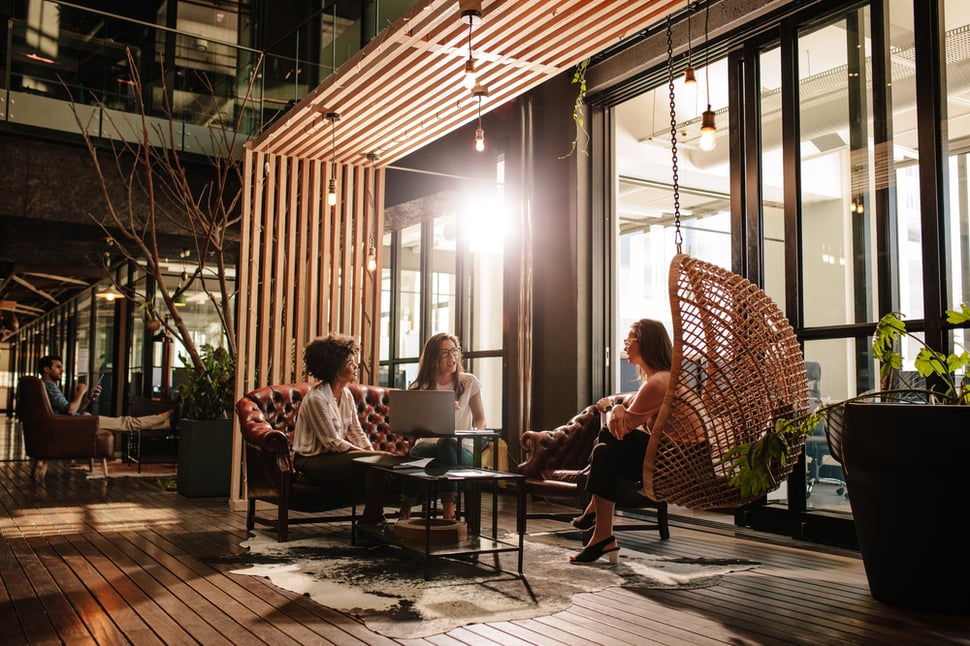
Betting on a hybrid workplace future
AT&T sees third spaces playing a vital role in the evolution of work, states Director of Workplace Strategy and Planning, Chris Mach. The way we use workplace space has changed forever, and while the future isn’t set in stone, there are emerging patterns which Mach and his team are identifying already.
The future of work has arrived. Here’s how to make it work for you.
Overview
Chris Mach is the Director of Workplace Strategy and Planning for AT&T Global Real Estate, and as such has seen his work subject to major disruptive change in the past 2 years, as both an employer and a service provider.
However, AT&T were well-positioned as a workforce, to weather the challenges recent events brought, in the sense of already being highly distributed. While they had to adapt to a more virtualized environment for their knowledge workers overnight, many of the building blocks were in place to transition fast.
Given the nature of their activities, this was good news for business continuity in general, when the lockdowns hit - with over 33% of their employees designated as essential workers, providing the data services we all depended on to keep work going. “I attribute a lot of our success in getting through the pandemic to our network guys - and those in competing companies - for keeping the bandwidth, and the decision-making lights on,” Mach acknowledged.
In his leadership role, however, he is very aware that connections within an organization depend on so much more than the broadband infrastructure.
“Keeping that connectedness, in a virtual environment, was fundamental to the psychology of the work that was happening,” Mach explained. HR folks in our C-Suite paid a lot of attention to making sure that our employees, even in that stressful and highly virtualized environment, had resources and programs they needed, to reach out to and utilize and even develop among themselves.”
This nurturing mindset supports where the organization finds itself today, as the workplace faces new challenges, in redefining and repositioning itself for a changed world.
Talent wars and the workplace of the future
Like many trends which the pandemic response accelerated and highlighted, the Great Resignation represents a longer-term problem which Mach and his colleagues had seen coming for some time. Recruiting and retaining top talent in the future of work will mean providing a total package which works on multiple levels, and adapts to the needs of individuals.
“Next we have to consider how we pivot, how to re-rationalize our workplace portfolio to accommodate hybrid work, and what are the appropriate ecosystems for work to take place” he explained. “Which use cases provide the best platforms for work?”
Visionary leaders have the chance to use the pandemic disruptions to go back to basics and consider how the needs of employees and organizations have changed for good, and create a better work environment that offers sustainable benefits for the future.
Mach continued: “[speaking for] my workplace group, there is a higher degree of attention spent on virtual connection and management of the team as a virtual community. There is a higher degree of softer skill sets needed to address the stresses and challenges of the past 2 years. I have a good number of essential folks – who were all impacted in one way or another. One needs to tune in with stronger empathy and listening skills and be able to detect where coaching and proactive communication for team connection is needed.”
Developing the ability to identify and respond to virtual cues helps managers to thrive in environments outside of a traditional physical workplace, while at the same time effectively support those doing vital on-site work with all the proper safety protocols.
When planning for future and current workplace needs, there are now 3 basic categories of work occupancy personas to consider: Office, Flex, and Virtual. “We have to anticipate what sort of demand will be needed for space, how that space will perform, and beyond physical space, what about the supporting aspects?” He continued. “Things like IT support, amenities, safety protocols, health insurance…”
Better meeting experiences
Workplace design also needs to take account of how people’s expectations have altered, after their experiences of working from home under lockdown. “Preferences are developing, for example in virtual meetings, to be more inclusive of those who are on the periphery.”
Ensuring participant equity and overcoming proximity bias in real-time collaboration is better for all participants, and for the quality of the work accomplished: “Most meetings in the future will predominantly involve participants within a corporate campus, also people from home, and potentially third workspaces,” Mach reflected.
To address these needs, the right technology, as well as facilitation skills, are necessary. “We want to ensure this type of meeting experience makes everyone feel included, it’s not an easy challenge, but it’s something we’re exploring every day…
“We are highly partnered with some of the largest names in tech, and that is at the forefront of discussion with our IT Operations folks. Workplace Strategy keeps abreast of the incoming technology strategies and develops workplace solutions with a small group of staff that I have – who I have recruited out of these organizations. More importantly, we are constantly asking this question for our internal guidelines and standards.”
Managing risk, and betting on the future
All of these far-reaching decisions are inevitably taking place against a backdrop of continued uncertainty - for AT&T as for every other business.
“We’ve got portfolio decisions coming up continually, and workplace decisions about what to invest where, with limited resources,” Mach admitted.
“The key is to retain a high degree of flexibility, within portfolio positioning and rationalization, or the physical fit of what you're doing within people’s spaces.
“So much is unknown,” he explained candidly, “Our biggest risk is where to make our bets. We do that through data, through evidence. It’s a continual iteration.
All of these practical facilities decisions are having to be made within a strategic context, taking many different factors into account simultaneously. “Where do we need to foster community? Where do we need to access talent? How do we need to bring people together, whether in a virtual or in-person context?
“It’s going to be a complex set of behavior patterns according to business type, leadership, and the future tackling of the risk of Covid. And it is going to change over the next 24 months”
“I don't think anyone knows the exact future of this, but we've got some good key indicators.”
Director of Workplace Strategy, AT&T

Office space: It’s not a case of either/or
“What we're going to see is a potpourri of activity, and we’re going to have to look at our presence data, do some surveying, really analyze what behaviors are taking place within space.
The way we use workplace space has changed forever, and while the future isn’t set in stone, there are emerging patterns which Mach and his team are identifying already - including less space being needed generally, versus an increase in high-functioning collaborative spaces. Spaces that support the decision-making lifeblood functions of knowledge work - wherever that takes place:
“I believe [central HQ offices] are going to be complimented in many areas by coworking and serviced offices and on-demand platforms, it's going to have a higher proportion of collaborative and meeting spaces, but it won't be dominated by that activity.
“Our current guess is 50-50 - we still see demand for people coming back and just doing focused work or having more traditional behaviors. Knowledge workers are essentially making decisions within space. And we're finding that post-pandemic, you can do that anywhere, to the degree that we can make those decisions faster, better, cheaper, more socially conscious, and sustainable.
“We're providing a toolset. And our toolset now consists of home, the campus, and the on-demand office.
This approach, sometimes called Hub & Spoke, will be influenced by practicalities such as parking and transportation access, influencing both perceptions of safety and ease of use. But Mach sees the third workplace as serving a vital part of future working paradigms - even if it doesn’t represent a large proportion, it can be the connective tissue that integrates the worlds of home and office-based working. “In fact, it may just be the 2 to 5% of your portfolio that adds the perfect complement to your talent’s needs. You may even find new models of hospitality and lean approaches to replicate in your portfolio, or even joint venture them.
“But it is a personal journey for each enterprise,” he concluded. “Find a good advocate and celebrate successes.”
For more advice on how to develop a hybrid workplace strategy that works for your business, contact us or visit LiquidSpace.com/Enterprise.
Ready to continue your journey?
There are two great ways to do it.
Ready to continue your journey?
There are two great ways to do it.






